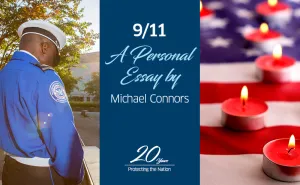
As we approach the 20th anniversary of September 11, TSA would like to rekindle that national unity and remind the next generation about why we serve. We asked TSA employees to submit a personal essay on how 9/11 impacted them, and how that has translated to their service to country and commitment to the TSA mission. You can view all essay submissions by visiting the TSA 9/11 iShare site from a TSA computer.
Calling in Serving to The Country
9/11: Why I Serve
When you proudly raised your right hand and took that oath. When you thought you had it all figured out, but life throws you a curve. When you had some of the worst and best times and stories of your life. When you lost and met lifelong friends. When you missed birthdays, holidays, and family gatherings. When you finally knew the cause was bigger. When you leave the service and know that you will still admire those doing the job. When you get it. When you never regret it. When you never forget it.
National Police Week drew to a close this year and the names of 394 law enforcement officers who died in the line of duty have been etched on the National Memorial in downtown Washington, D.C. Of those deaths, 182 were COVID-related. Ninety-nine died as far back as 1911, and their sacrifice is only now being recognized. 2020 was one of the deadliest years for law enforcement. Each name serves as a reminder of the potential peril cops face every day. The National Law Enforcement Museum in Northwest D.C. reopened this August with a new exhibit called “Post 9/11” that will explore how the terror attacks changed law enforcement over the past 20 years. And to that, this author is no exception. This is why I serve. This is my story.
Prior to joining the Federal Air Marshal Service, I served honorably in the U.S. Coast Guard. My first unit was a 110’ Patrol Cutter homeported where I grew up in N.J. I held multiple leadership positions such as an Officer of the Deck; Cutter Navigator; Cutter Rescue Swimmer; Law Enforcement Boarding Officer; and Small Boat RHI Coxswain (boat driver). Charged with patrolling the North Atlantic coastline to include 200 miles from shore, I enforced federal laws, U.S. treaties, and conducted lifesaving Search & Rescue missions. Homeported 25 minutes south of New York harbor, my USCG Cutter ADAK often provided vessel security zones for special events, such as the Macy’s 4th of July Fireworks display, regatta series power and sailboat races, and New York’s annual Fleet Week.
Immediately following the 9/11 terror attacks in NYC, my unit and I arrived and witnessed first-hand the devastation of the WTC Towers collapsing. Our crew of just 16 members and I immediately assumed on-scene command of the harbor and worked tirelessly to assist in the crisis. One memory I have of that horrific day happened while driving the Rigid Hull Inflatable (RHI) 17’ boat just south of the ferry terminal. I vividly recall the winds blowing the smoke, debris, and burning ash littering the air from west to east with a strange smell. I remember maneuvering over and grabbing a still burning piece of full-sized copier paper out of the air, blowing it out along its edges, folding it up, and putting it into my bright orange life jacket pocket. I didn’t know what it meant then, but I do now. Another memory was during operational control of all water assets. I identified a problem and quickly applied a unique communication solution that efficiently and effectively managed first responder vessel assets (NYPD, FDNY, Ferry’s) in the harbor. My crew and I helped set the precedence for the largest maritime evacuation in history. Again, I didn’t know what it meant then, but I do now.
For my efforts, I was awarded the Secretary of Transportation’s 9/11 Medal and the National Defense Medal. Recently, I received the Global War on Terrorism Medal from the U.S. Coast Guard for my service at ground zero. I plan to donate it to the National Law Enforcement Museum as 9/11 led me to my current career. I believe in the mission. This is why I serve.
FAMS Michael T. Connors
